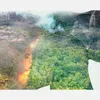These changemakers are connecting people with nature in innovative ways
Here is a list of social entrepreneurs and artists who show their love for nature in innovative ways.
There are many ways one can connect and create a positive impact on the nature around them. It can be anything—from showcasing your love through arts to adopting sustainable practices to involving in different drives to protect the environment.
Here are a few personalities who are trying to create an impact on the environment in innovative ways.
Seema Anand and Prashant Dhawan
Bengaluru-based architects Seema Anand and Prashant Dhawan believe that we need to break the silos of our learning, look to nature, and take an open and interdisciplinary approach to innovation.

They started Biomimicry India to promote how design can be realigned to be in sync with nature and takes this insight to schools, universities, companies, and ordinary people across India.
Since 2014, the couple has worked with schools, colleges, and corporates to conduct online workshops that introduce the concepts of biomimicry and why it is the way forward for a better future.
Since then, Biomimicry India has conducted over 190 biomimicry workshops and talks across disciplines and age groups. It has reached more than 25,000 people. Biomimicry has been successfully taught across IITs, NIDs, NIFTs, ISBs, etc.
Mehul Kumat
Born and brought up in Udaipur, Rajasthan, Mehul Kumat has fond childhood memories of taking long walks along the city’s green trails, listening to the pitter-patter of the rain during monsoons, and gazing at the glistening water bodies.
He was disheartened upon witnessing the degradation of these landscapes. However, he didn’t lose hope and decided to do his bit to revive the water bodies.

In 2018, he established Kritaash—a non-governmental organisation aimed at restoring the ecological community. ‘Kritaash’, which translates to ‘hope for a better future’, is involved in recycling waste paper into useful products and organising afforestation drives from its proceeds.
To draw the attention of young minds to various environmental issues, Mehul and his friends took the initiative to conduct workshops across many schools in Udaipur.
Gunjan Shrivastava
A PhD holder in visual arts, Gunjan Shrivastava’s signature nature-inspired works involve using aged and torn leaves to capture the theme of natural decay.
Passionate about sustainable art and living, she rejoices over the fact that more artists are adopting sustainable practices in their art forms by looking for non-toxic colours and eco-friendly packaging options.

During COVID-19, she conceptualised a new collection—The Natural Resurrection—where she explored the healing process of the environment and its consequent resurrection through her painting.
The message through this body of work was to establish our responsibility towards the environment we live in and nurture it with care.
As a mentor of change at the Atal Innovation Mission, she also works closely with grassroots emerging artists from rural India who are not exposed to the international market and lack the social skills to express themselves.
Varun Ravindra
Varun Ravindra had always been passionate about conserving the environment and forests and started Vanantara to revive barren land and make it sustainable.
In 2016, he founded Vanantara by buying 100 acres of land (near the Karnataka-Tamil Nadu border). It now has over 40,000 trees across over 250 species of trees.

He wanted to offer “a safe adventure" to people who aspire to go down this path but are living lives entrenched in the city to allow them to move on this path, alongside contributing to the larger movement of alleviating climate change and helping protect and nurture the planet's biodiversity.
Varun says that the Vanantara team first forested the land and invited like-minded members to be part of this community and movement. Collectively, they created a forest ecosystem at Vanantara with size, scale, and benefits that would not have been possible individually.
Edited by Suman Singh



![[Sustainability Agenda] Investing in environment-friendly approaches in business? Here's why you've hit a goldmine](https://images.yourstory.com/cs/5/f5a7f3304b1211e9b6645b8ae897d03e/Screenshot2022-06-08at9-1654661360534.png?fm=png&auto=format&h=100&w=100&crop=entropy&fit=crop)




